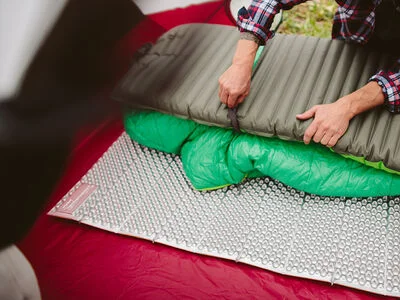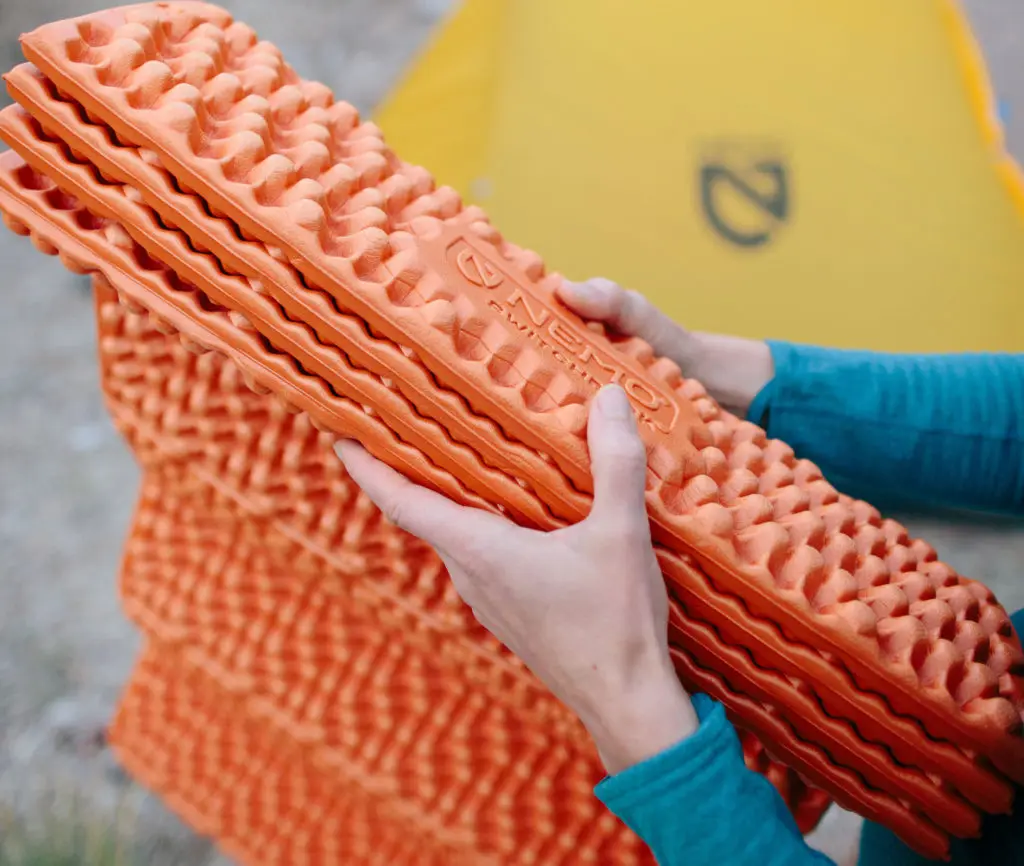When planning a backpacking adventure, a good night’s sleep is important for staying energized and alert for the journey ahead. One essential piece of equipment for achieving proper rest is a sleeping pad. With numerous types and styles available on the market, two main categories stand out – foam pads and air pads. Each type comes with its own set of benefits and drawbacks, which backpackers must carefully consider before making their choice.
Foam sleeping pads are a classic choice often favored for their durability and lightweight nature. Made from closed-cell foam, these pads insulate sleepers against the cold ground and provide a firm sleeping surface. They also resist absorbing moisture, making them less susceptible to damage. Despite their advantages, some find foam pads’ bulkiness and lack of cushioning problematic, especially when packing for extended trips.
On the other hand, air pads offer a more cushioned sleeping surface and often pack down to a smaller size, making them popular among weight-conscious backpackers. They combine air chambers with insulation to provide both comfort and warmth. However, their thin construction leaves them more vulnerable to punctures or leaks, which can lead to unexpected discomfort during a trip.
Comparing Foam and Air Sleeping Pads

Weight Comparison
Foam sleeping pads are usually lighter than air sleeping pads. They are made of a closed-cell foam material which provides a stable and insulating surface without adding excessive weight. On average, foam sleeping pads weigh between 8-20 ounces.
Air sleeping pads, on the other hand, are inflatable and usually weigh more due to the fabrics and construction required to make them durable and airtight. They generally weigh between 12-30 ounces, depending on size and materials used.
Comfort Comparison
When it comes to comfort, air sleeping pads can offer a more cushioned and personalized sleeping surface. They allow users to adjust firmness by inflating or deflating the pad, catering to individual preferences. However, they can be more susceptible to puncturing or leaking, which can lead to discomfort during sleep.
Foam sleeping pads provide a consistent level of firmness and padding, which some may find more preferable. Although they may not offer the same level of cushioning as air pads, they are less prone to damage and maintain their shape over time.
Insulation Comparison
Insulation is an important aspect when considering a sleeping pad. Foam sleeping pads offer better insulation due to their closed-cell foam design. These pads trap air within the foam structure, creating a barrier between the sleeper and the cold ground. Their insulation capabilities remain consistent even when compressed.
Air sleeping pads, by design, rely on the air inside them for insulation. This can result in lower insulation performance when compared to foam pads, especially in colder conditions. Inflatable pads with built-in insulation materials can improve their thermal capabilities but may come at the cost of added weight and bulk.
In summary, both foam and air sleeping pads offer advantages and disadvantages when it comes to weight, comfort, and insulation. While foam pads are often lighter and provide consistent insulation, air pads offer a more customizable comfort level. It is essential to consider personal preferences and intended use when selecting the best option for your backpacking adventures.
Check out our guide on the 6 Best Budget Sleeping Pads Under $100
Pros and Cons of Foam Sleeping Pads

Advantages of Foam Sleeping Pads
Foam sleeping pads are a popular choice among backpackers for various reasons. One of the main advantages is their durability. They are made from closed-cell foam which is highly resistant to punctures and tears, making them perfect for rugged terrains.
Another notable advantage of foam sleeping pads is their affordability. They tend to be less expensive than their air-filled counterparts, making them a budget-friendly option for backpackers.
Foam pads are also better insulators as they have inherent insulating properties, helping to retain body heat and stabilize temperature during cold nights. They also provide a firm and supportive surface, which may be preferable for some people.
Lastly, foam pads are relatively low-maintenance, as they do not require inflation or deflation, making them easy to set up and pack away.
Disadvantages of Foam Sleeping Pads
Despite their numerous advantages, foam sleeping pads also have some drawbacks. One significant disadvantage is their bulkiness. They do not compress well and take up more space in a backpack compared to inflatable sleeping pads.
Another disadvantage of foam pads is their limited cushioning. While they provide a firm and supportive surface, they might not be as comfortable for people who prefer a softer sleeping surface.
Additionally, foam pads can be harder to clean than air pads, as dirt and moisture may become trapped within the closed-cell foam. They may also be heavier than air-filled pads, depending on the thickness and size of the pad.
Foam sleeping pads have various advantages such as durability, insulation, and affordability. However, they also have some drawbacks, including bulkiness, limited cushioning, and weight. These factors should be carefully considered by backpackers when deciding on a sleeping pad option.
Pros and Cons of Air Sleeping Pads

Advantages of Air Sleeping Pads
Air sleeping pads are a popular choice among backpackers and campers for several reasons. First and foremost, they are lightweight and compact. When deflated and rolled up, air sleeping pads can easily fit into a backpack without taking up much space or adding significant weight. This is an attractive feature for backpackers who need to minimize their load.
Another advantage of air sleeping pads is their customizable firmness. Users can manually adjust the air pressure to their preference, providing a more comfortable and personalized sleeping experience. Furthermore, air sleeping pads often offer better insulation than foam pads, as the air trapped inside creates a barrier against the cold ground.
Some additional benefits of air sleeping pads include:
- Durability: High-quality air sleeping pads are usually made of strong materials like ripstop nylon, ensuring long-lasting use.
- Ease of setup: Most models are easy to inflate and deflate, with some even self-inflating.
Disadvantages of Air Sleeping Pads
Despite their advantages, air sleeping pads also come with a few drawbacks. One of the most significant concerns for users is the potential for punctures or leaks. Accidents can happen, and even the most durable pads might suffer damage from sharp rocks or debris. A punctured pad can significantly impact the user’s comfort and insulation, potentially leading to a sleepless night in the outdoors.
Another disadvantage is the slipperiness of air sleeping pads, as they tend to be smoother than foam pads. This can cause users to slide and shift during sleep, potentially leading to discomfort or waking up on the cold ground.
Some other downsides of air sleeping pads include:
- Noise: Air sleeping pads may produce annoying crinkling sounds when users move or shift during sleep.
- Cost: Generally, air sleeping pads are more expensive than foam pads, making them less accessible for budget-conscious backpackers.
- Inflation time: Manual inflation pads require extra effort and time to set up, which can be inconvenient after a long day of hiking.
In summary, air sleeping pads offer numerous advantages like lightweight, compactness, and better insulation, but also come with some drawbacks such as potential punctures, slipperiness, and a higher cost. While each type of sleeping pad has its pros and cons, it’s essential for campers and backpackers to weigh their priorities and choose the one that best suits their needs and preferences.
Choosing the Right Sleeping Pad

Climate
When selecting a sleeping pad for backpacking, you should consider the climate of the location where you will be camping. The two main types of sleeping pads, foam and air, provide differing levels of insulation. Foam sleeping pads generally offer better insulation, making them a suitable option for colder environments. Air sleeping pads, on the other hand, are adjustable in thickness and can be more accommodating in warmer climates. However, some air pads come with insulation or have a higher R-value, providing enough warmth for colder temperatures as well.
Trail Type
The type of trail you will be backpacking on is another factor to consider when choosing a sleeping pad. For rocky or uneven ground, an air sleeping pad can help alleviate pressure points and provide a more comfortable sleep, while the durability of foam sleeping pads makes them less susceptible to punctures on rough terrain.
Here’s a comparison of foam and air sleeping pads:
| Foam Sleeping Pad | Air Sleeping Pad | |
|---|---|---|
| Durability | High | Medium |
| Comfort | Medium | High |
| Insulation | Good | Varies |
| Weight | Light to Medium | Light |
Personal Preference
Lastly, personal preference plays a significant role in selecting a sleeping pad. Some backpackers might prefer the convenience and ease of a foam pad, which doesn’t require any inflation. Others may opt for an air pad’s adjustability and comfort. It’s essential to try out different sleeping pads to determine which option best suits your individual needs. The key is to find a balance between comfort, weight, and insulation that works for you and the specific conditions of your backpacking adventure.

Care and Maintenance Tips
Taking care of your sleeping pad, whether it’s foam or air, will help extend its lifespan and ensure you get the best performance during your backpacking adventures. Here are some general care and maintenance tips for both types of pads.
Storage: When not in use, store your sleeping pad in a cool, dry place, away from direct sunlight and extreme temperatures. For foam pads, keep them unrolled or loosely rolled, without any straps or cords compressing the foam. Air pads should be deflated and stored loosely folded or rolled, with the valve open to allow any residual moisture to escape.
Cleaning: After each trip, clean your sleeping pad by wiping it down with a damp cloth and a mild soap, avoiding harsh chemicals that may damage the materials. Allow the pad to air-dry before storing it away. For air pads, be sure to fully inflate and deflate them a few times during the cleaning process to get rid of any trapped dirt or debris.
Inspection: Periodically inspect your sleeping pad for any signs of wear or damage, such as punctures, tears, or delaminating foam. Address any issues early on to avoid compromising the pad’s insulation and comfort properties.
Repair: For foam pads, small tears can be repaired with a durable adhesive tape, while larger damages may require replacement sections. Air pads can be patched using repair kits provided by the manufacturer or purchased separately. Be sure to follow the specific repair instructions for your particular pad.
By following these care and maintenance tips, you’ll make sure your backpacking sleeping pad stays in top condition, providing you with comfort and a good night’s sleep during your outdoor adventures.
Choosing a Sleeping Pad for Backpacking
When choosing a sleeping pad for backpacking, it’s important to consider the benefits and drawbacks of both foam and air pads. Foam pads offer the advantages of being lightweight, durable, and affordable. They provide insulation and cushioning for a comfortable night’s sleep. However, their bulkiness and limited comfort options can be a downside for some backpackers.
On the other hand, air pads offer a higher level of comfort and customization, as they can be adjusted to meet individual preferences. They are also more compact, making them easier to transport. However, they have a higher price point and require more care in handling due to their vulnerability to punctures.
Ultimately, the choice between foam and air pads comes down to personal preference, budget, and specific needs. Backpackers who prioritize durability, low cost, and insulation may prefer foam pads, while those who prioritize comfort, compactness, and customization may opt for air pads. By carefully weighing the pros and cons of each type, backpackers can make an informed decision suited to their individual requirements.
We’ve detailed out the 6 Best Budget Sleeping Pads Under $100, including multiple foam and air sleeping pad options that work great for backpacking. These pads are made by quality manufacturers who utilize durable materials and have been trail-tested.
Frequently Asked Questions
What are the main differences between foam and air sleeping pads?
Foam sleeping pads are made of durable, closed-cell foam material that provides cushion and insulation without the need for inflation. Air pads, on the other hand, require inflation but offer more comfort and often superior insulation due to trapped air.
Which type of pad offers better insulation and warmth?
Both foam and air pads can provide adequate insulation and warmth, but the performance varies depending on the design and materials used. Generally, air pads tend to offer better insulation due to their thicker profile and air chambers, which help to block the cold ground better than foam pads. However, high-quality foam pads with a high R-value can also provide excellent insulation from the cold.
How do foam and air pads compare in terms of weight and packability?
Foam pads tend to be lighter and less bulky than air pads but can be more challenging to pack due to their rigid structure. Air pads, although usually heavier, are more compact when deflated and rolled up. It’s important to consider the weight and packability of a sleeping pad in relation to your backpacking needs and preferences.
Can you use a foam pad and an air pad together for added comfort?
Yes, many backpackers use a foam pad as a protective layer underneath an air pad to provide extra insulation, comfort, and protection from punctures. Combining the two types of pads can offer a more comfortable and warmer sleep, especially during colder nights.
Which pad is more durable, foam or air?
Foam pads are generally more durable due to their solid construction, whereas air pads can be susceptible to punctures and leaks. However, the durability of an air pad depends on the quality of the materials and construction, as some high-quality air pads can be very resilient. It’s essential to care for your sleeping pad and follow guidelines for use and maintenance to ensure longevity.
What are the key factors to consider when choosing a sleeping pad for backpacking?
When choosing a sleeping pad for backpacking, consider insulation, weight, packability, comfort, durability, and price. Prioritize these factors based on personal preferences, type of trip, and expected weather conditions. It may be helpful to test out different sleeping pads at a store or rent them before purchasing to find the best option for your needs.

